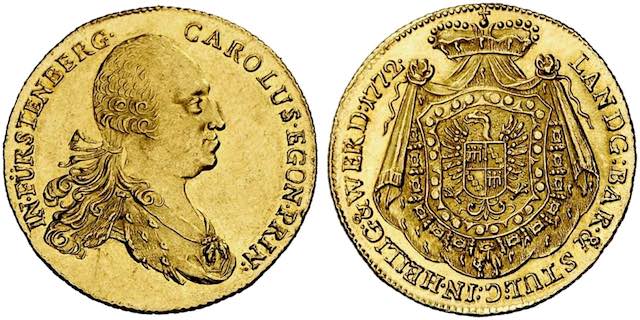|
The founder of the order, Philip the Good, appointed the first 24 knights of the order in 1430. They were recruited from his disparate dominion and were to be formed into a community of loyalty and support. The founder of the order saw himself as the first among equals. In the initially regular assemblies (called chapters), the order community completed itself by electing 30 members for life.
Alfonso V, King of Aragon and Naples, became the first "foreign" member in 1445. For him, the oath of allegiance had to be weakened, and of course he remained absent from chapter meetings and festivities. Under the second Sovereign of the Order, Charles the Bold, further foreigners were elected as members of the Order: King Edward IV of England (1468), King Ferdinand II of Sicily (1473) and King Ferdinand of Naples (1473). As coinage sovereigns, these rulers could have presented the order on their coins. However, this only happened with members of the Order who were appointed later. |
|
Baden
Of the holders of the Order of the Golden Fleece who do not belong to the family of the monastery,
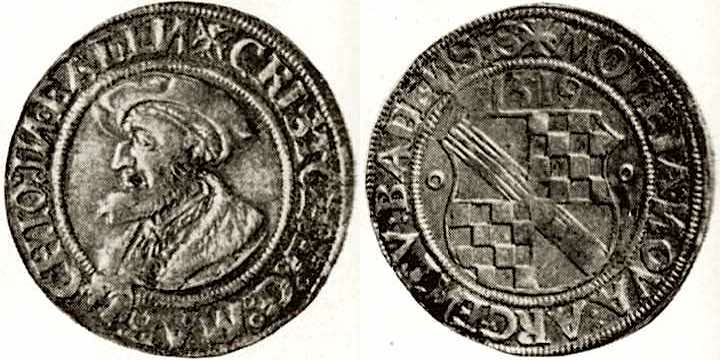
Dicken 1519, Baden Baden. Ø c.30 mm, c.9,5 g. Wielandt 122. Obv.: CRISTOF:D:G:MAR - CHIO: IИ BADEИ Bearded bust left, wearing coat and cap. The Golden Fleece on the ribbon reaches into the inscription. Rev.: MOИETA·ИOVA·ARGEИTV:BADEИSIS Squared coat of arms of Baden (slanting bar) and Sponheim (chessboard), date above.


Ducat 1674, Baden Baden. Ø 21 mm, 3,47 g. Wielandt 255; Friedb.122. Obv.: ፨GVILIELM·D·G·MARCHIO·BADENsis·Et·HACHBERGensis·Langravius·In Bust right, chain of Order of the Golden Fleece on the breast. Rev.: ·Susenbergensis·COMES·In·SPONHeimensis·Et·EB - ERSteinensis·Dominus·In·Röteln·Badenweiler· Lahr·Et·Mahlberg·&I674 - Coat of arms surrounded by the order chain with attached Golden Fleece. 
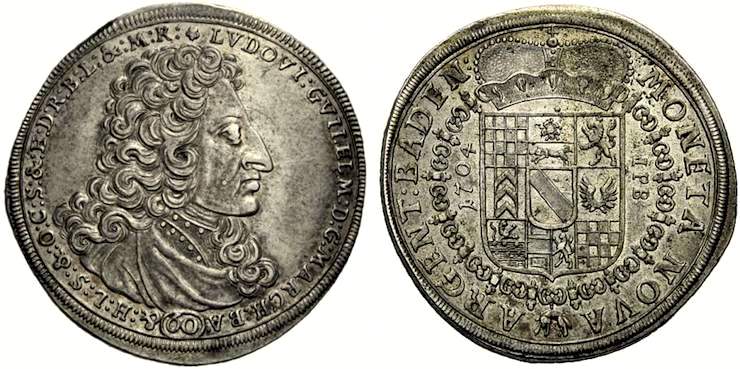
Gulden of 60 Kreuzer 1704, Würzburg. Rolling mill coinage. Ø 36 mm, ca.17 g. Wiel.327; Dav:237. Obv.: ¤LVDOVI:GVILELM:D:G:MARCHio·:BAdensis· - &:Hachbergensis:Langravius:Susenbergensis:&: Ortenaviensis:Comes:Sponheimensis:&:Ebersteinensis:Dominus:Rötelnensis:Badenvillensis:Lohrensis:&:Malbergensis:R: Draped and armored bust with wig to the right, the value 60 in the oval below. Rev.: MONETA NOVA - ARGENT:BADEN: Multi field coat of arms [Sponheim, Eberstein, Breisgau. 2nd row: Badenweiler, Baden (center), Hachberg. Below: Rötteln, Lahr-Malberg, Sponheim] under princely hat and between 1704 and IPB (sign. Johann Peter Bischoff), surrounded by the chain of the Order with the Golden Fleece. The Margraviate of Baden-Baden comprised many separate tracts of land between the Hunsrück and the Upper Rhine.
|
|
Bavaria
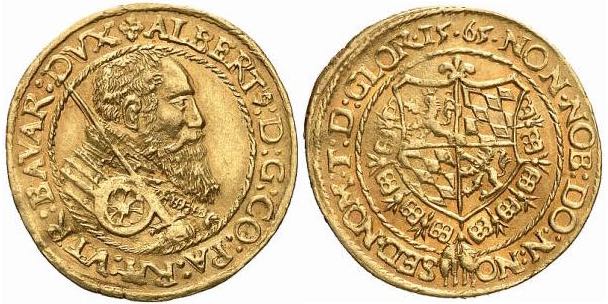
2 ducats 1565, Munich. Ø 25 mm, 7,03 g. Hahn 52; Friedb.182. Obv.: + ALBERT'us:Dei:Gratia:COmes:PAlatinus:RHenii:VTRiusque:BAVARiae:DVX "... Count Palatine of the Rhine and Duke of both (Upper and Lower) Bavaria" Armored bust, shouldering a sword with his right hand, Order chain with Golden Fleece on the chest. Rev.: ·NON·NOBis:DOmine:Non:NObis - SED·NOMine:Tuo:Da:GLORiam·15·65 "Not us, oh Lord, not us, but give glory to Thy name!" Four-field coat of arms (Palatinate/Bavaria), surrounded by the chain of the Order of the Golden Fleece. The fire stones in the chain spark asymmetrically, single inwards and triple outwards.
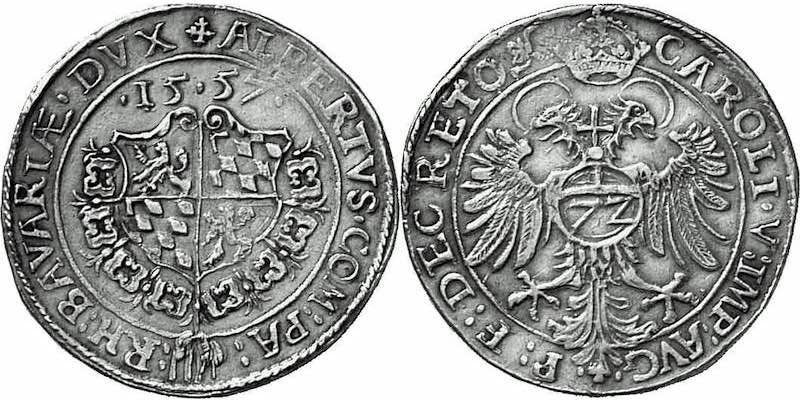
Reichsguldiner of 72 Kreuzer 1557, Munich. Ø 40 mm, 30,82 g. Hahn 46; Dav.8922. Obv.: ALBERTVS·COMes:PAlatinus: - RHenii:BAVARIÆ·DVX Squared coat of arms hung with the fleece order, above the date ·15·57·. Between the sparking fire stones are two fire irons, whose handles are movably hooked together. Rev.: CAROLI·V:IMPerator:AVGustus - Permisit:Fieri:DECRETO "... allowed the production" Crowned double-headed eagle, on the chest the orb with the value 72.

Ducat 1596, Munich. Ø 21 mm, 3,47 g. Hahn 56; Friedb.186. Obv.: GVIL:D:G:COmes:PAlatinus - RHEnii:VTRiusque·BAVAriae·DVX· Crowned, quartered coat of arms surrounded by the chain of Order with the Golden Fleece. Rev.: ·S·HEN:ROM:IMP - E - Rator:DVX·BAVA· The crowned St. Heinrich of Bavaria standing from the front in armor and with a cloak wrapped around him, holding a scepter in his right hand and an orb in his left. An eccentrically punched piece, which was made by well-centered rollers aligned in the same direction (↑↑).
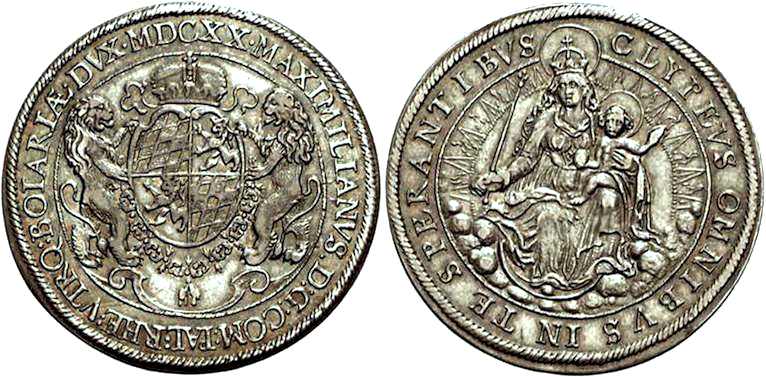
Madonna Thaler 1620, Munich. Ø 42 mm, 27,80 g. Hahn 62A; Dav.6064A. Obv.: ·MAXIMILIANVS·D:G·COM:PAL:RHE:VTRiusQue:BOIARIÆ·DVX·MDCXX· Crowned, oval coat of arms (Bavaria/Palatinate) held by two lions, who also lay the order chain with the Golden Fleece around the coat of arms. Rev.: CLYPEVS OMNIBVS IN TE SPERANTIBVS "(A) shield to all who hope in you" (Ps. 18,31) Madonna with child and scepter on clouds surrounded by aureoles. Child Jesus with apple.

Double thaler 1627, Heidelberg, for the Rhine Palatinate. Ø 42 mm, 58,04 g. Hahn 157; Dav.6094. Obv.: MAXIMILIANVS·D:G:COM:PAL:RHENI:VTRI·BAVARIÆ·DVX· Armored bust to the right with a lion's head on the shoulder, a draped cloak and the chain of the Order of the Golden Fleece, next to the arm section the die cutter's mark MS. Rev.: SACRI·ROMani·IMPerii·ARCHIDAPIFER·ET·PRINCEPS·ELECTOR "'Archsteward' and Elector of the Holy Roman Empire" Two lions hold the double-helmeted four-field coat of arms (lozenge/lion) with central shield (orb, electoral insignia of the Palatinate), the chain of the Order hangs on the sides. Below the Golden Fleece between the date 16-G - C-27 (GC for Georg Crämer, mint administrator in Heidelberg 1624-28). Because of the special prominence of the title 'Archidapifer' (archsteward), it is assumed that this thaler was specially minted to celebrate the re-establishment of the office of archsteward that year.
The portrait of the Bavarian Elector Maximilian I is documented on coins only in the present Heidelberg issue, which also included single thalers and possibly also 1½-fold thalers from the same dies.

Madonna thaler 1694. Ø 42 mm, ca. 29 g. Hahn 199; Dav.6099. Obv.: MAXimilianus:EMANUEL D.G.Vtriusque.Bavariae&Palatinatus.Superioris.Dux.Comes.Palatinus.Rheni. Sacri.Romani.Imperii.Archi.Dapifer&Elector·Langravius·Leuchtenbergensis· Draped, armored bust with large wig to the right. Rev.: CLYPEVS OMNIBVS IN TE SPERANTIBVS∗1694 "Ein Schild allen, die auf dich hoffen" (Ps.18,31) Crowned Madonna with child and scepter sitting on clouds, the left holding the oval coat of arms with attached fleece order chain. Maximilian II Emanuel, 1704-14 in exile in the Netherlands 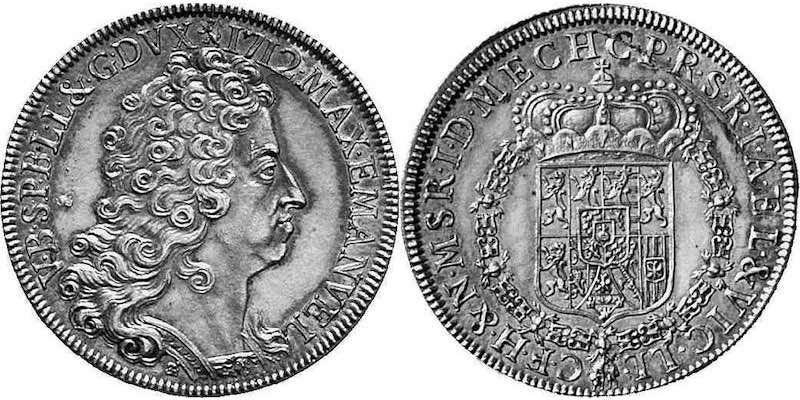
Thaler 1712, Namur or Paris. Ø 39 mm, 27,98 g. Delm.364; Witt.1708; Hahn 220; Dav.1271A. Obv.: MAX·EMANVEL - Vtriusque·Bavariae·Superioris·Palatinatus·Brabantiae·Limburgi·Luceburgi·&·Geldriae·DVX (Mz. Löwe) 1712 Bare head with wig and indicated armor to the right. Rev.: Comes·Palatinus·Rheni·Sacri·Romani·Imperii·Archidapifer·ELector·&·VICarius·LangraviusLeuchtenbergensis· - Comes·Flandriae·Hanoniae·&·Namurci·Marchio·Sacri·Romani·Imperii·Dominus·MECHlinae Multi-field coat of arms under a crown surrounded by the Order of the Fleece.
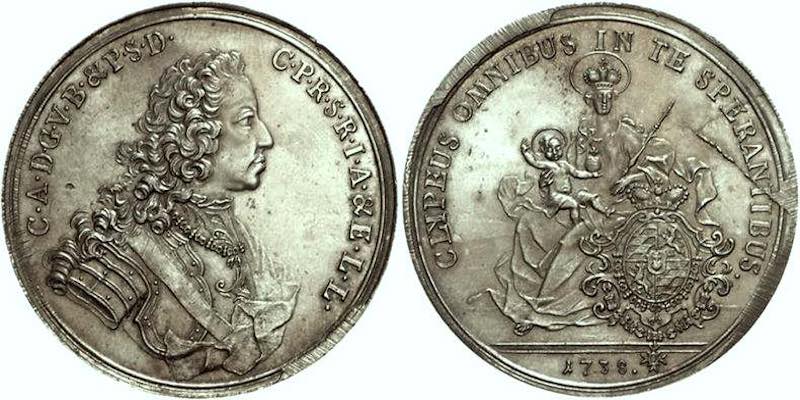
Thaler 1738, Munich. Ø 43 mm, 29,4 g. Hahn 248; Wittelsbach 1938; Dav.1942. Obv.: Carolus·Albertus·Dei·Gratia·Vtriusque·Bavariae & Palatinatus·Superioris·Dux· - Comes·Palatinus·Rheni·Sacri·Romani·Imperii·Archidapifer·& Elector·Langravius·Leuchtenbergae· "Karl Albrecht by the Grace of God, Duke of both Bavaria and the Upper Palatinate, Count Palatine at the Rhine, Archtruchsess and Elector in the Holy Roman Empire, Landgrave of Leuchtenberg" Armored bust with the chain of the Order of the Golden Fleece, below a ribbon. Rev.: CLYPEUS OMNIBUS IN TE SPERANTIBUS. - "A shield to all who hope in you" Seated St. Mary holding the infant Jesus with orb on her lap, holding sceptre in her left hand, crowned Bavarian coat of arms beside. Central arms: Imperial orb as spa badge. Two chains of orders around the arms: the Habsburg Golden Fleece and the Bavarian Holy George Cross renewed in 1728. Exergue: 1738.
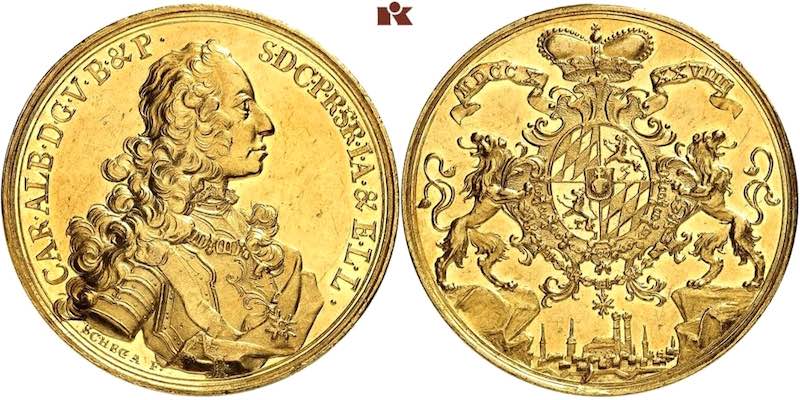
10 ducats 1739, Munich. Ø 47 mm, 34,98 g. Hahn 248; Witt.1868Ann.; Friedb.227. Obv.: CAR·ALB·D·G·V·B·& P·S·D·C·P·R·S·R·I·A·& E·L·L· (title exactly as before). Armored bust right, order chain with the Golden Fleece (hidden by a curl of the wig), underneath the Order of St. George, at the arm section the signature of die cutter F. A. Schega. Rev.: Two lions standing on rocks hold together the four-field coat of arms (Bavaria/Palatinate) with an orb in the central shield, toped by an electoral crown and surrounded by the chain of the Order of the Golden Fleece, below the chain of the Order of St. George, below a view of the city of Munich, at the top to the sides of the crown inscription with the date MDCCX - XXVIIII.
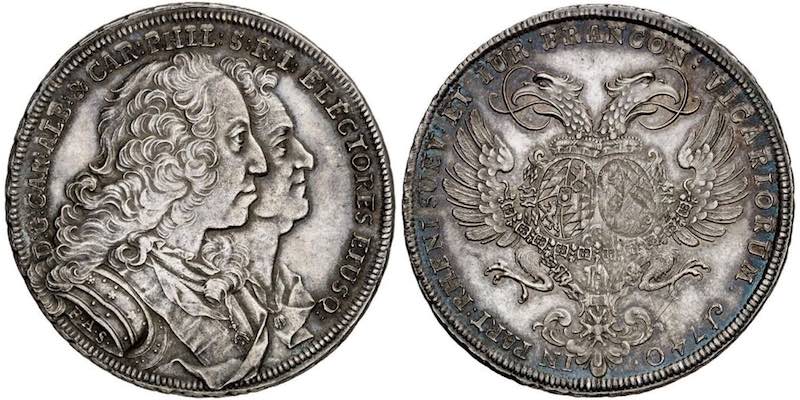
Thaler 1740, Munich, on the Vicariate. Ø 43-44 mm, ca.29 g. Hahn 264; Dav.1945. Joint issue with Karl Philipp, Elector Palatine. Obv.: D:G:CAR:ALB:& CAR:PHIL:Sacri:Romani:ELECTORES EIUSQue: "..., Electors of the Holy Roman Empire and" Busts of the two electors to the right, each with a Golden Fleece on a ribbon. At the arm section: F·A·S· (F.A.Schega, die cutter). Rev.: IN PARTibus:RHENI SUEViae:ET·IURis·FRANCONici:VICARIORUM·J740· "Vicar in the countries of the Rhine, Swabia and Franconian law" Nimbered double-headed eagle, on the chest the crowned coats of arms of Bavaria and the Palatinate, surrounded by the chains with the Order of the Golden Fleece and the Bavarian Order of St. George. A variant of this Bavarian Vikariate thaler
 (Dav.1946) shows three orders on the reverse: Order of St. George
on the chain around the Bavarian coat of arms, Hubertus Order on the ribbon around the (Dav.1946) shows three orders on the reverse: Order of St. George
on the chain around the Bavarian coat of arms, Hubertus Order on the ribbon around thePalatinate coat of arms, in between the Golden Fleece.

Double gold gulden 1740, Munich, on the Vicariate. Ø 23 mm, 6,47 g. Hahn 268; Friedb.238. Obv.: CAR·ALB·D·G·Utriusque·Bavariae· - DUX ARCHIDux [!]·& ELector· - head to the right. Rev.: VICARIUS & PROVISOR IMPERY[II] & C[?]·1740· Coat of arms with close-fitting chain of the Order of St. George overlaid by the chain of the Fleece Order. Karl Albert related to the imperial coronation in 1743 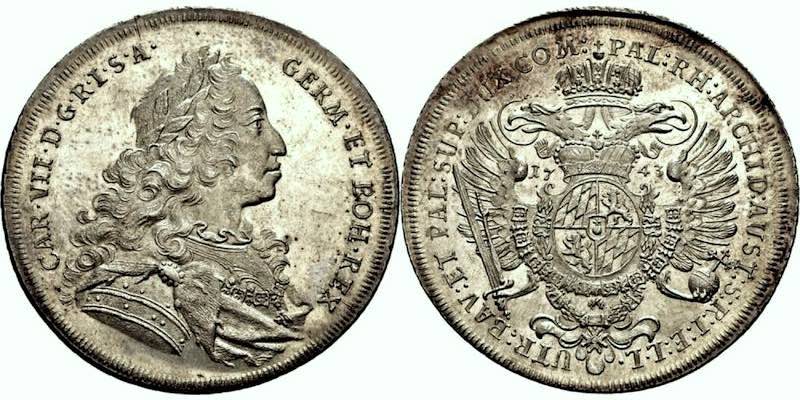
Thaler 1743, Munich. Ø 42 mm, 29,16 g. Hahn 277; Witt.1964; Dav.1947. Dies from F. A. Schega. Obv.: CAR·VII·D·G·Romanorum·Imperator·Semper·Augustus· - GERManiae ·ET BOHemiae·REX "..., Emperor (*1), German and Bohemian (*2) king" Armored bust right, with laurel wreath and the Golden Fleece on the Order chain. Rev.: UTRiusque:BAVariae:ET:PALatinatus:SUPerioris:DUX COMes: - PALatinus:RHeni: ARCHIDux:AUSTriae:Sacri:Romani:Imperii:Elector:Langravius·Leuchtenbergensis· "... Archduke of Austria (*3), Elector, Landgrave ..." - Imperial crown with inful above the double-headed eagle, crowned coat of arms on the chest. Chains of the Order of the Golden Fleece and of the Bavarian Order of St. George, sword, scepter and orb in the claws. Date 17-43.
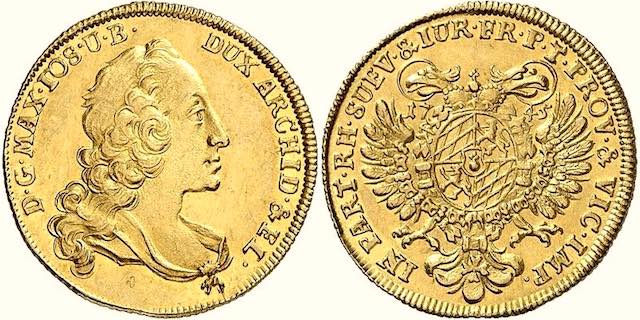
Ducat 1745, Munich, on the Vicariate. Ø 21 mm, 3,48 g. Hahn 281; Friedb.241a. Obv.: D·G·MAX·IOS·U·B· - DUX ARCHID·& EL· - Bust right with Fleece Order on collar. Rev.: IN PART·RH·SUEV·& IUR·FR·P·T·PROV·& VIC·IMP· Double-headed eagle, on the breast the four-field coat of arms (Bavaria/Palatinate) with central shield (orb) covered with the electoral hat, surrounded by the chain of the Order of the Golden Fleece, also the chain of the Order of St. George, date 17 - 45 at eagle's heads.
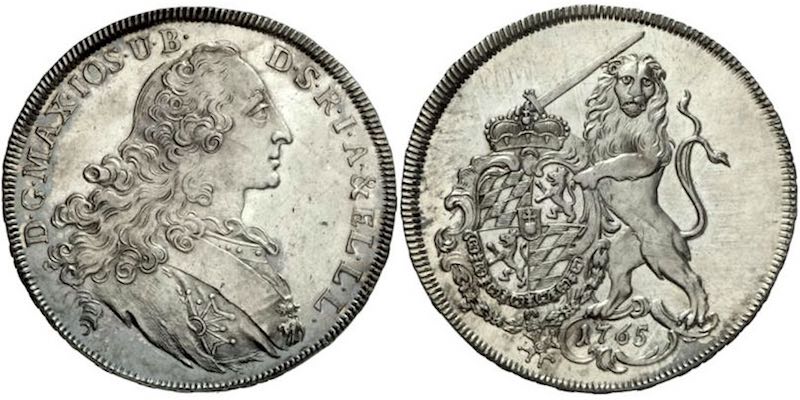
Convention Thaler 1765, Munich. Ø 42 mm, ca.28 g. Hahn 310; Wittelsbach 2179; Dav.1955A. Obv.: D·G·MAX·IOS·Utriusque·Bavariae· - Dux·Sacri·Romani·Imperii·Archidapifer·&ELector· Landgravius·Leuchtenbergae - Bust to the right in an ermine, wearing a sash, the Order of the Golden Fleece on the chest and the Order of Saint George to the side. Rev.: Lion standing upright holding a sword in his right paw and with his left the Bavarian coat of arms draped with two chains of orders and covered with the electoral hat. A cartouche with the date 1765 at the bottom. Also called "Arslani thaler", as it was supposedly intended for trade with the Levant.
The name comes from the Turkish word Arslan, which means lion.
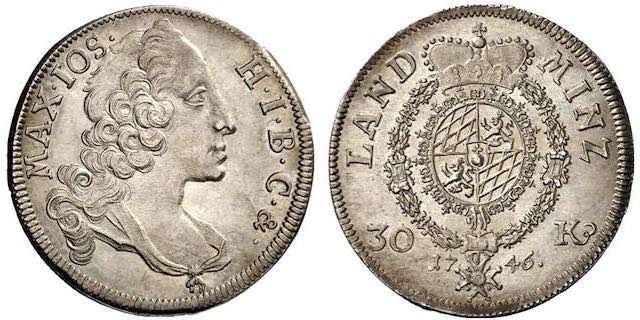
1/2 guilder (30 kreuzer) 1746, Munich. Ø 30? mm, ca.7 g. Witt.2182; Hahn 303. Obv.: MAX·IOS· - Herzog·In·Bayern·Churfürst·&· - Bust right, Fleece Order on ribbon. Rev.: LAND - MUNZ - Crowned coat of arms surrounded by two chains of orders. "Landmünze" are coins minted inferiorly, which were only valid in the territory of the coin emitter.

4 Groschen (12 Kreuzer) 1766, Munich. Ø 26 mm, ca.4,3 g. Witt.2194; Hahn 297.
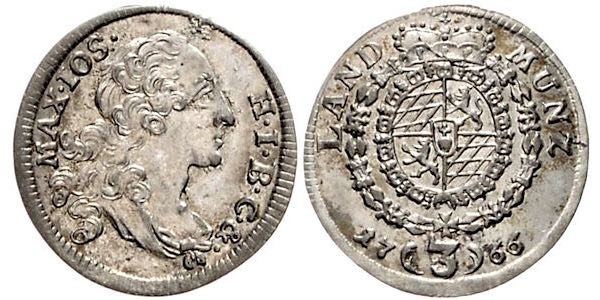
3 Kreuzer (Groschen) 1766, Munich. Ø ? mm, 1,49 g. Hahn 292. Obv.: MAX·IOS· - Herzog·In·Bayern·Churfürst·&· - Bust right, Fleece Order on ribbon. Rev.: LAND - MUNZ - Crowned coat of arms surrounded by chains of orders. Maximilian III Joseph died in 1777 without male issue. He was succeeded by Karl Theodor of Palatinate. |
|
Brunswick and Lueneburg
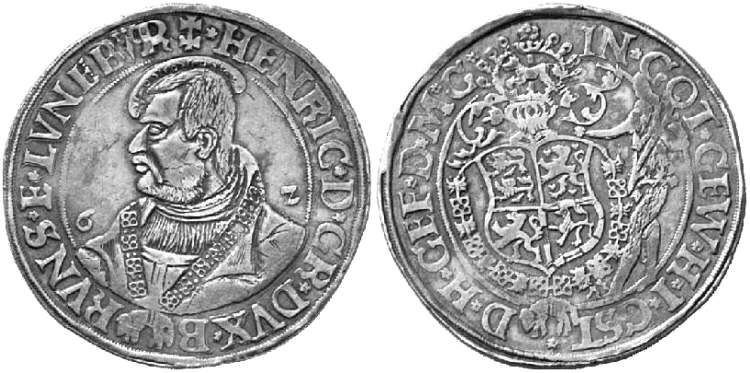
Thaler 1562, Goslar. Ø 41 mm, 28,8g. Welter 399; Dav.9051 Obv.: ·HENRICus·Dei·GRatia·DVX·B - RVNSviecum·Et·LVNEBVRgensis ‡ (‡ mint mark) "Henry by the Grace of God Duke of Brunswick and Lüneburg" Draped bust with cap and Fleece Order chain between the date 6 - 2. Rev.: IN GOTts GEWalt Hab Ich (mein Sach) GeSTellt - Der Hat's GEFügt Dass Mir's Genügt Squared coat of arms (above: Brunswick-Lueneburg; below: Everstein-Homburg) with helmet, crest and hanging chain with Fleece Order; a wild man wearing a wreath of leaves as a loin guard.
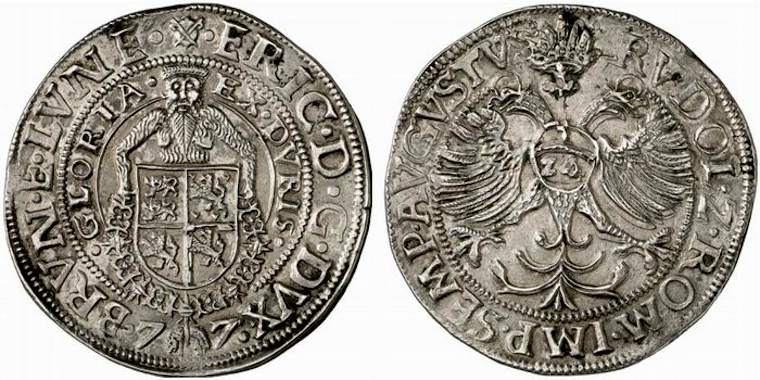
Thaler (24 Groschen) 1577, Münden. Ø 43 mm. Dav.9007. Obv.: ·ERIC·D·G·DVX· - ·BRVNsvicensis·Et·LVNEeburgensis· Wild man stands behind the quartered coat of arms and holds the chain of the Order of the Golden Fleece around the coat of arms; the Golden Fleece between the divided date 7 - 7. In the field: ·GLORIA· - EX·DVRIS· "Mastering difficult tasks earns prestige" Rev.: RVDOLphus·Z(II)·ROManorum·IMPerator·SEMPer·AVGVSTVs (title of the reigning emperor) Crowned double-headed eagle with orb on the chest, the value Z4 in the orb. Exactly in the year 1573, in which Erich received the order, the coin image of this thaler was supplemented by the order, in such a way that the wild man no longer holds the shield but now the chain of the order.
|
|
Palatinate
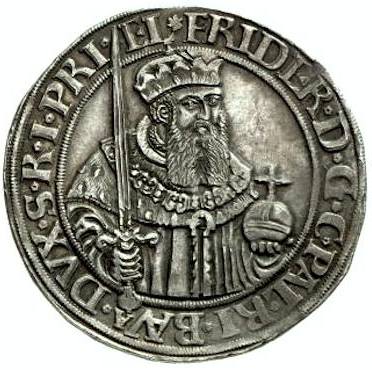
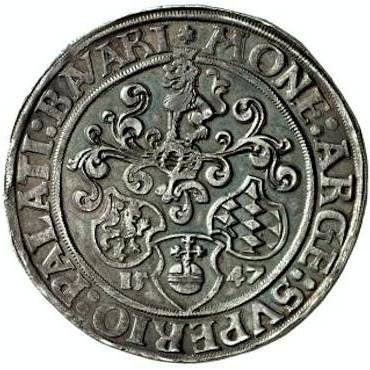
Thaler 1547, Neumarkt. Ø 40 mm, 28,3 g. Dav.9626. Obv.: ¤FRIDER·D·G·Comes·PALatinus·RhenI·BAVAriae·DVX·S·R·I·PRI·EL S.R.I.P.EL = Sacri.Romani.Imperii.Princeps.ELector = Elector of the Holy Roman Empire Hip portrait in electoral regalia with electoral hat, electoral sword and imperial orb as well as Order of the Golden Fleece. Rev.: ¤MONEta:ARGEntea:SVPERIOris:PALATInatus:BAVARIae "Silver money of the Bavarian Upper Palatinate" - Under the Palatinate helmet the three coats of arms: Palatinate (crowned lion) / Bavaria (diamonds) / Electoral Palatinate (orb), below the date 15 - 47. See other coins of the Elector bearing his effigy and the Order of the Golden Fleece. |
|
Palatinate-Neuburg and Jülich-Berg

Thaler n. d., Kallmünz (Upper Palatinate). Ø 43 mm, 28,73 g. Dav.7164. Obv.: *WOLFG·WIL:Comes:PAlatinus:RHEni:DVX:BAvariae:IVLiaci:CLIviae·Et·MONTinum Bust left, with ruff and Golden Fleece on the ribbon. Around: IN·DEO·MEA· - CONSOLTIO· "In God is my consolation" Rev.: COomes:VELdentiae·SPonhemii:MArcae:RAVensbergae: - ET:MORSiae:DOMinus:In:RAVenstein Title on both sides: "Count Palatine on the Rhine, Duke of Bavaria, Jülich and Berg / Count of Veldenz, Spohnheim, Mark and Ravensberg, Lord of Ravenstein" Crowned quartered coat of arms surrounded by a chain of orders with the Golden Fleece (die error on fleece). 
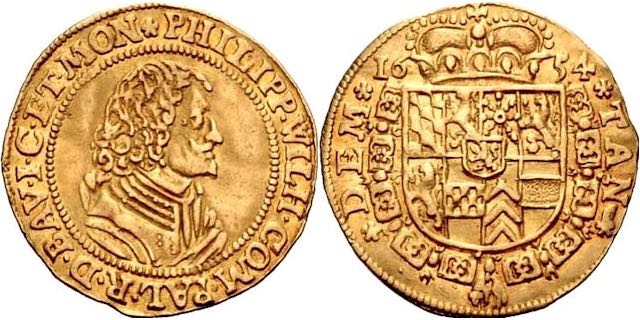
Ducat 1654, Düsseldorf. Ø 22 mm, 3,41 g. Noss 667; Friedb.1392. Obv.: *PHILIPP·WILH·COMomes·PALatinus·Rheni·Dux·BAVvariae·Iuliaci·Cliviae·ET·MONtium Bare-headed, armored bust to the right. Rev.: *TAN* - *DEM* "at last" - Crowned, multi-field coat of arms surrounded by the chain of the Order with the Golden Fleece, above the divided date.
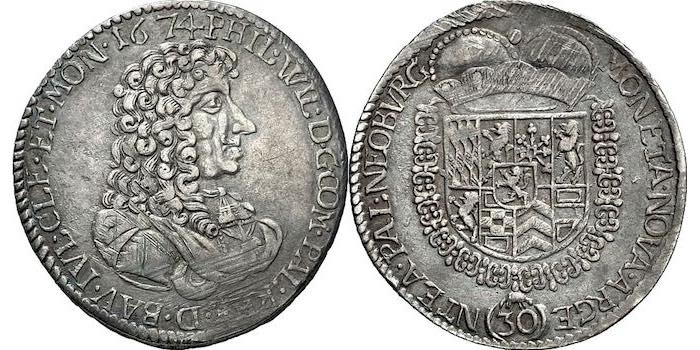
30 Kreuzer (1/2 Gulden) 1674, Neuburg. Ø 31-32 mm, 9,42 g. Noss 415. Obv.: PHIL·WIL·D·G·COM·PAL·RHE·D·BAV·IVL·CLE·ET·MON·1674 Armored and draped bust to the right with wig and Golden Fleece on a ribbon on the chest. Rev.: MONETA·NOVA·ARGE (30) NTEA·PAL·NEOBVRG Coat of arms covered with a prince's hat, around it a chain with a Golden Fleece. Value at the bottom: (30). The piece was made by roller milling on a strip, from which it was punched out and then adjusted to weight with a file. During the rolling process, the height of the coin increased compared with the width.
The alignment of both sides is the same (↑↑).
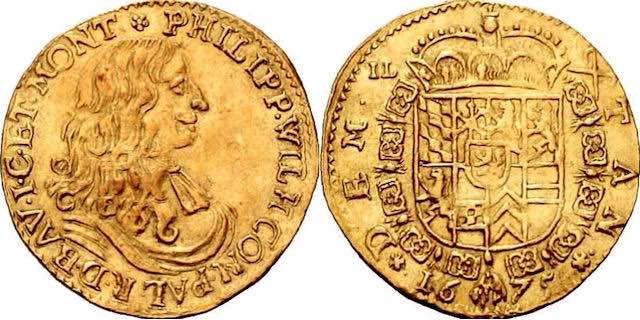
Ducat 1675, Mülheim. Ø 22? mm, 3,43 g. Noss -; Friedb.1392. Obv.: *PHILIPP.WILH COM·PAL·R·D·BAV·I·C·ET·MONT - Draped, armored bust to the right. Rev.: TAN* - *DEM· - Crowned multi-field coat of arms surrounded by the chain and Order of the Golden Fleece, above IL - crossed strip hook (Johann Longerich, mint master), below the date 16 -75. 
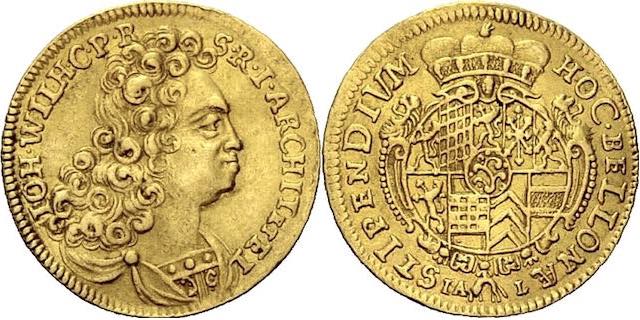
Ducat 1707 as chronogram. Ø ? mm, 3,44 g. Noss ?; Friedb.2009. Obv.: IOH·WILH·Comes·Palatinus·Rheni - Sacri·Romani·Imperii·ARCHIThesaurarius ET ELector Armored bust to the right. Rev.: HOC·BELLONÆ - STIPENDIVM "?" Crowned coat of arms cartouche surrounded by the chain of orders. The Golden Fleece between IA - L (die cutter Johann Linck). Chronogram : CLLIDIVM = MDCLLVII = 1707
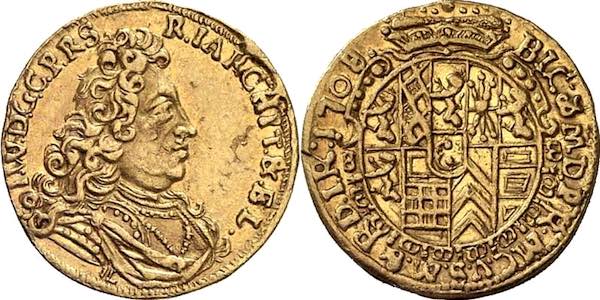
1/2 Ducat 1708, Heidelberg. Ø 15 mm, 1,72 g. Coll.Memmesh.2393; Friedb.2018. Obv.: I.W.D.G.C.P.R S - R.I ARCHIThesaurarius.&.ELector. Bust to the right, draped and with orden on the chest. In section IL (die cutter Johann Linck) Rev.: BavariaeI[=J]uliaciCliviae&MontiumDux PRrinceps·Meursiae Comes.Veldentiae.SSponheim.Marcae.& Ravensbergae·Dominus.In.Ravenstein:1708 Crowned coat of arms surrounded by the Order chain without Golden Fleece. A similar half ducat from 1705
 also shows the Golden Fleece on the reverse. also shows the Golden Fleece on the reverse.

Thaler 1709, Düsseldorf. Ø 42 mm, 29,16 g. Noss 841; Dav.2364. Obv.: Dei Gratia IOHannes WILHelmus Comes Palatinus Rheni - Sacri Romani Imperii ARCHIDapifer & ELector Rev.: Bavariae Iuliaci Cliviae & Montium Dux PRriceps Meursiae Comes Veldentiae - Sponhemi Marcae & Ravensbergae Dominus In Ravenstein 1709 Regalia shield with the imperial orb between two national coats of arms under the electoral crown, Order of St Hubert and below the Order of the Golden Fleece. Arms on the left: Bavaria, Jülich, Kleve, Berg and Palatinate (middle). Arms on the right: Mörs, Veldenz, Mark and Ravensberg.
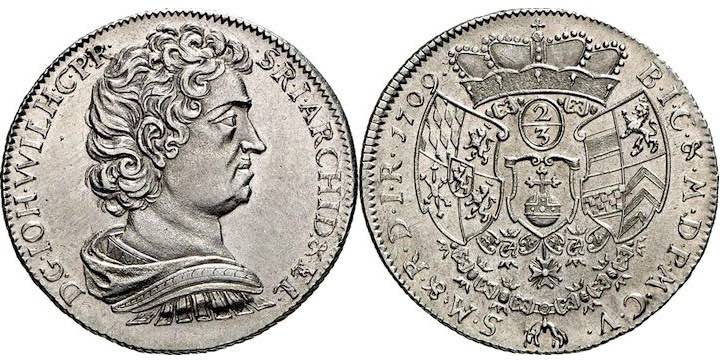
2/3 Thaler 1709, Düsseldorf. Ø 33-35 mm, 17,34 g. Noss 843a; Dav.597. Similar as before.

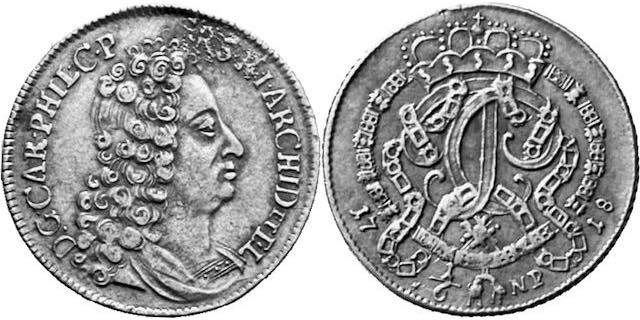
1/6 Thaler (1/4 Gulden) 1718, Düsseldorf. Ø 24 mm, ? g. Noss 890. Obv.: D.G CAR·PHIL·C·P - R·S·R·I·ARCHID ET EL - bust to the right. Rev.: Crowned and wrapped monogram surrounded by the order chain, hanging from it the Golden Fleece between 1/6 - NP, laterally 17 - 18. The encircling band is the chain of the Order of St. Hubert, which is placed directly below the monogram.
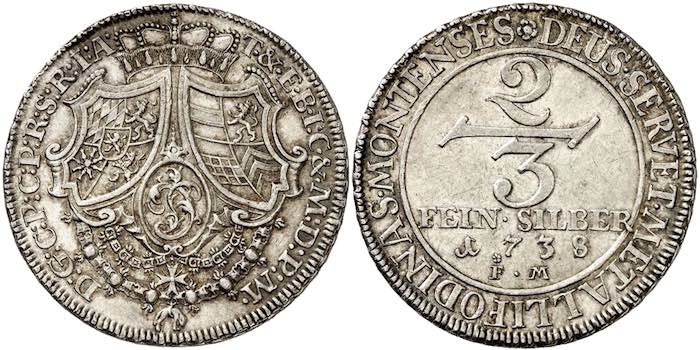
2/3 Thaler 1738, Düsseldorf. Ø 33 mm, ca.12,8 g, fine silver. Noss 947; Dav.602. Yield of the Bergische Gruben (Wildberg). Obv.: Dei:Gratia:Carolus:Philippus:Comes:Palatinus:Rheni:Sacri:Romani:Imperii:Archi - Thesaurarius·&·Elector·Bavariae·Iuliaci·Cliviae·&·Montium:Dux:Priceps:Meursiae· Under the electoral hat, three shields set into a carved frame; the Jülich Order of Hubert and the chain of the Order of the Golden Fleece. Rev.: *DEUS·SERVET·METALLIOFODINAS·MONTENSES "God protect the Bergische ore mines" Value, fineness, date and mint mark F·M. The chain of orders consists of oval flints, from which sparks fly, connected to irons that are hinged together. In the chain of the Hubertus Order there are alsosparking elements.

2/3 Thaler 1737, Düsseldorf. Ø 33 mm, 12,98 g, fine silver. Noss 944; Dav.600. Obv.: Dei:Gratia:Carolus:Philippus:Comes:Palatinus:Rheni:Sacri:Romani: - Imperii:Archi:Thesaurarius&Elector:Bavariae:Iuliaci:Cliviae·&·Montium:Dux:Princeps·Meursiae· Armored and draped bust, Order of the Fleece on the chest. On the arm section M (J.Marmé, die cutter). Rev.: FEIN· - SILBER - Electoral hat over two coats of arms. Monogram in between, below Order of Hubert and Order of the Fleece. In section: denomination 2/3 between date 17 -37 and F. - O. (Franz Offner, mint master). At the same time, the following 2/3 thaler was minted in Mannheim, but it only names Palatinate titles. 
2/3 Thaler 1737, Mannheim. Ø 33 mm, fine silver. Noss 356; Dav.747. C·PHIL·D:G·C·P·R·S· - R·I·ARCHIT&EL // CHVR·PFALZ·1737 On the chest: pendant with Golden Fleece. Under the arm section: SCHAEFFER (die cutter at Mannheim).
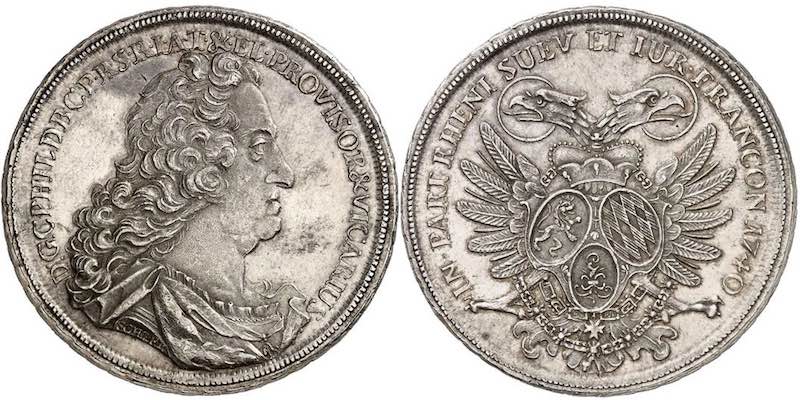
1½-fold Thaler 1740, Mannheim, on the Vicariate. Ø 43 mm, 43,81g. Haas 25; Dav.2529. Obv.: D:G.C PHIL Dux Bavariae Comes Palatinus·Rheni·Sacri·Romani·Imperii·Archi·Thesaurarius·&· ELector·PROVISOR&VICARIUS "... Elector, administrator and vicar" (continuation on the obv.) Armored bust of the 79-year-old Elector right with Order of the Golden Fleece. Rev.: IN·PARTibus RHENI SUEVici ET IURis·FRANCONici·1740 "... in the Rhenish and Swabian areas as well as Franconian law" Double headed eagle with the three Palatinate coats of arms on the breast, above the electoral hat. Under the shields the chains of the Order of St. Hubert and the Order of the Golden Fleece.
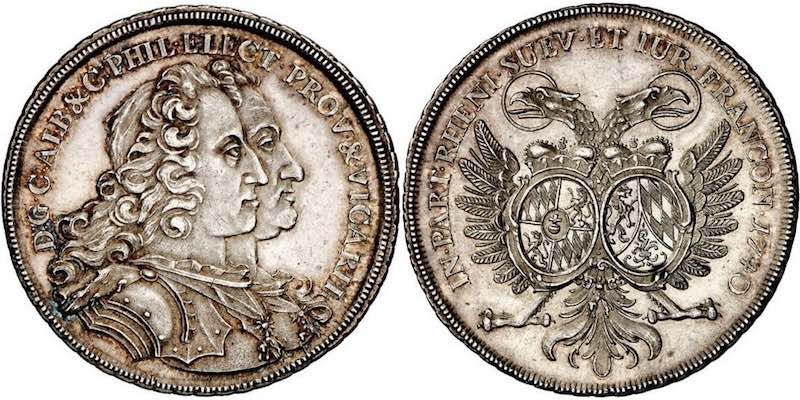
Thaler 1740, Mannheim, on the Vicariate. Ø 43 mm, 43,81g. Haas 27; Dav.2530. Joint issue with Karl Albert of Bavaria. Obv.: D:G·C·ALB&C·PHIL·ELECT·PROVisor·&·VICARII "..., Electors, administrators and governors" Both busts to the right, each with a Golden Fleece hanging on a ribbon. Rev.: IN·PARTibus·RHENI·SUEViae·ET IURis·FRANCONici·1740 "In the Rhineland, Swabia and the areas of Frankish law" Double-headed eagle, the Bavarian and Palatinate coats of arms on the breast, underneath the Golden Fleece. |
|
Palatinate-Bavaria
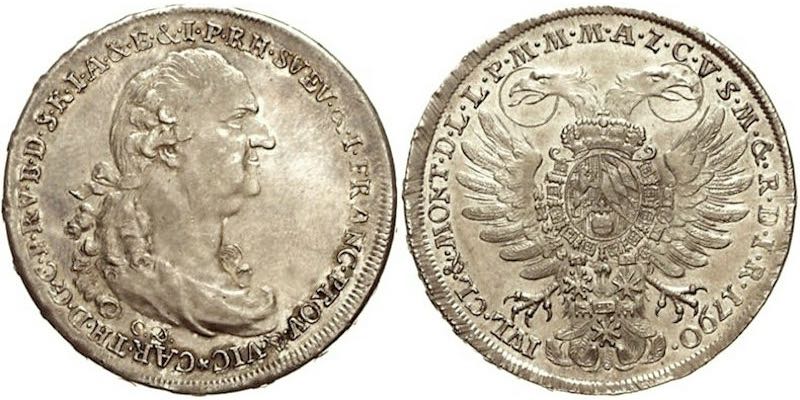
Convention thaler 1790, Munich. Ø 41 mm, ca.28 g. Hahn 360; Dav.1970. On the Imperial Vicariate after the death of Emperor Leopold II. Obv.: CARolus THeodorus, Dei Gratia Comes Palatinus Rheni, Vtriusque Bavariae Dux, Sacri Romani Imperii Archidapifer & Elector & In Partibus RHeni, SVEViae & Iuris FRANConici PROVisor & VICarius "Karl Theodor, by the grace of God Count Palatine on the Rhine, Duke of the Two Bavarians, Archtruchsess of the Holy Roman Empire and Elector, protector in the area of Rhenish and Swabian law" bust to right with an ermine cloak and hair tied at the nape of the neck, underneath C.D. (Cajetan Destouches, die cutter). Rev.: IVLiaci CLiviae & MONTium Dux, Landgravius Leuchtenbergensis, Princeps Meursii, Marchio Montis Ad Zomam, Comes Veldentiae, Sponheimi, Marcae & Ravensbergae, Dominus In Ravenstein, 1790 Nimbed double-headed eagle, on the breast the three-part coat of arms of Palatinate-Bavaria covered with the electoral hat and hung with four chains of the Order - of the Golden Fleece, St. George, St. Hubert and St. Michael.
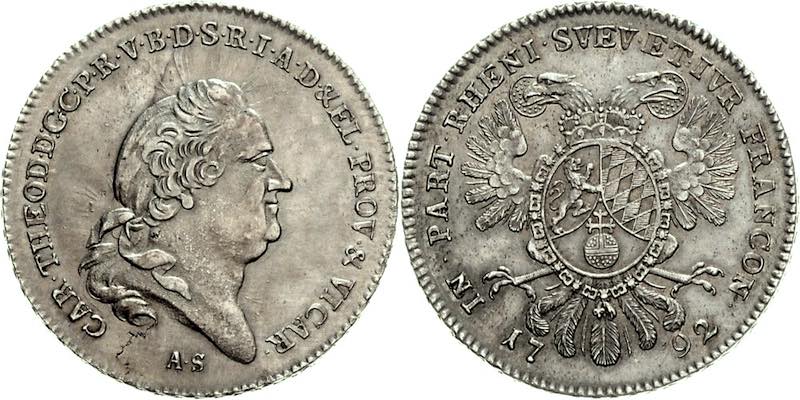
Convention thaler 1792, Manheim, on the Vicariate. Ø 40 mm. Hahn 403; Dav.1974. Obv.: CAR·THEOD:D:G·C·P·R·V·B·D·S·R·I·A·D·&EL·PROV·&VICAR· Nude bust to the right, with a hair bow. Below A·S (Anton Schäffer, die cutter). Rev.: IN·PART·RHENI·SVEV·ET·IVR·FRANCON· - Nimbed double-headed eagle, crowned round coat of arms (Palatinate/Bavaria/Imperial Apple) on the chest. Surrounded by a order chain of the Golden Fleece. Below date 17 - 92.

Convention thaler 1792, Munich, on the Vicariate. Ø 40 mm. Hahn 367; Dav.1973. Obv.: C·TH·D G Comes Palatinus Rheni Vtriusque Bavariae Dux Sacri Romani Imperii Archidapifer & Elector & In Partibus RHeni SVEVici & In FRanconia PROVisor & VICarius Nude bust to the right, without hair bow, no sign below. Rev.: JVLiaci·CLiviae·&·Montium·Dux·Landgravius·Leuchtenbergae·Princeps·Meursiae·Marchio·Montis· Ad·Zomam·Comes·Veldentiae·Sponhemi·Marcae·&·Ravensbergae·Dominus·In·Ravenstein· Double-headed eagle as above, but multi-fielded and almost rectangular coat of arms. Below the chains and signs of four different orders as well as the divided date. The title of the coin's issuer requires the legend of both sides and does not forget an old unrealistic claim to the small dominion of Ravenstein at the river Maas.
A little later, a new era begins in which ordens are hardly ever displayed on coins.
|
|
Continuation, Part 2b: more appointed knights
Overview
Order of the Golden Fleece on coins and medals
1. Sovereigns of the Order
Part 1a : Philip the Good - Emperor Charles V
Part 1b : King Philip II - Spanish / Austrian branch 2. Appointed knights
Part 2a : Baden, Bavaria, Brunswick & Lueneburg, Palatinate, Palatinate-Neuburg, Palatinate-Bavaria, Fürstenberg Part 2b : Poland, Saxony, Rietberg, Wuerttemberg Part 2c : Italy, Spain, ..., Transylvania Part 2d : Austrian new princes |
 Start page
Start page

